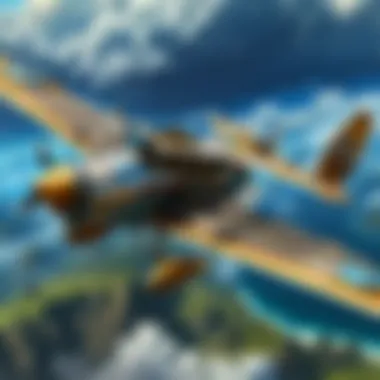Revolutionizing Flight: The Unfolding Story of the Flying Machine's Evolution


Game Updates and Patch Notes
The evolution of flight represents a captivating journey through time, highlighting mankind's relentless pursuit of conquering the skies and pushing the boundaries of innovation. From the rudimentary origins of early flying machines to the sleek and sophisticated aircraft of today, the metamorphosis of aviation unveils a tapestry woven with ambition, creativity, and ingenuity.
Transitioning from the Wright brothers' groundbreaking first flight to the intricate engineering marvels of modern airliners, each epoch in aviation history provides a glimpse into the vast progression and technological feats achieved in the quest to revolutionize flight.
Strategy Guides and Tips
Within the realm of flying machines, a strategic approach is indispensable, involving intricate details, sophisticated technologies, and refined maneuvers to navigate the skies with precision and finesse. Understanding the nuances of aerodynamics, pilot techniques, and aircraft dynamics embodies the essence of mastering the art of flight.
Delving deeper into the intricacies of flight, exploring the dynamics of lift, thrust, drag, and weight unravels the underlying principles that govern the skies. From mastering takeoff and landing procedures to executing complex aerial maneuvers, the dexterity required to pilot aircraft epitomizes a fusion of skill, knowledge, and sheer audacity.
Lore and Story Analysis
Beyond the mechanical intricacies lies a tapestry of stories, lore, and historical accounts that breathe life into the evolution of the flying machine. Each aircraft tells a tale of innovation, perseverance, and human ambition, shaping not only the skies above but also the narratives that echo across generations.
Diving into the narratives that encapsulate aviation history, from the daring escapades of early aviators to the modern sagas of aerospace exploration, unveils a rich tapestry of characters, triumphs, and setbacks that define the profound impact of flight on society and culture.
Mod Reviews and Add-ons
Amidst the technological marvels of aviation, the realm of modifications and add-ons offers a unique perspective on enhancing the flying experience. From cockpit enhancements to flight performance upgrades, the world of aviation simulations teems with customized features and user-generated content that redefine the boundaries of virtual flight.
Exploring the diverse landscape of flight simulation modifications, from weather overhauls to immersive airport sceneries, provides enthusiasts with a platform to personalize their flying adventures and tailor the in-flight experience to their preferences. Embracing the world of mods and add-ons unlocks a realm of infinite possibilities, enriching the aviation experience with creativity and customization.
I. Early Concepts of Flight
Exploring the genesis of flight is quintessential in elucidating the trajectory of aviation history, encapsulating the nascent stages of human ingenuity and the quest for aerial dominion. The section on Early Concepts of Flight serves as a foundational cornerstone in our narrative, delving deep into the visionary concepts that paved the way for modern aviation marvels. Whether dissecting the anatomical wonders of bird flight or navigating through the imaginative sketches of early innovators, this section unravels the essence of mankind's enduring fascination with soaring among the clouds.


A. Leonardo da Vinci's Vision
In the annals of intellectual history, Leonardo da Vinci stands as a colossus, his visionary brilliance transcending generations. Within the realm of flight, da Vinci's imprint looms large, particularly through his esoteric designs and conceptual blueprints. One such marvel is his Ornithopter Design, a precursor to modern-day aircraft propulsion systems. Shunning conventional norms, da Vinci's Ornithopter mimicked avian flapping mechanisms, symbolizing the convergence of nature's elegance with human innovation. Despite its prototype status, the Ornithopter's influence on Future Innovations reverberates across centuries, infusing a spirit of experimentation and relentless pursuit of flight enhancements.
B. Early Aviation Pioneers
Venturing beyond the confines of theoretical musings, Early Aviation Pioneers like Otto Lilienthal and the Wright Brothers catalyzed the flight evolution process through tangible experiments and tangible achievements. Lilienthal's Gliders symbolize a leap of faith into the unknown, showcasing the gradual refinement of aerodynamic principles and the quintessence of controlled flight. In a parallel narrative, the Wright Brothers' Successful Flight epitomizes the pinnacle of aeronautical breakthroughs, punctuating the skies with the exultant cry of triumphant human ambition. Both narratives interlace, underscoring the indomitable spirit that propels aviators towards the heavens, overcoming earthly constraints towards a realm of boundless exploration and discovery.
II. Technological Advancements
In the exploration of the evolution of the flying machine, the section on technological advancements stands as a pivotal chapter. Here, we delve into the intricate mechanisms and innovations that have propelled aviation to new heights. Technological advancements in aviation play a critical role in enhancing aircraft performance, safety, and efficiency. By focusing on propulsion systems, navigation, and control, this section sheds light on the significant strides made in aeronautical engineering.
A. Propulsion Systems
1. Introduction of Jet Engines
An essential milestone in aviation history, the introduction of jet engines revolutionized the way aircraft operate. Jet engines are renowned for their unparalleled power and efficiency, propelling airplanes at speeds previously unimaginable. The key characteristic of jet engines lies in their ability to generate thrust through the combustion of fuel and accelerated exhaust gases. This technological leap has significantly contributed to quicker travel times, increased payload capacities, and improved fuel efficiency in modern aircraft. Despite their advantages, jet engines require meticulous maintenance and are susceptible to high operational costs, factors that are carefully considered in the context of this article.
2. Impact of Propeller Design
While jet engines have dominated the realm of propulsion, the impact of propeller design should not be overlooked. Propeller-driven aircraft have their unique advantages, especially in terms of operational costs and suitability for certain aircraft configurations. The key characteristic of propeller design lies in its ability to convert engine power into propulsive force efficiently. This design choice remains popular for smaller aircraft and specific applications where jet engines may not be the most optimal solution. Understanding the impact of propeller design provides insights into the versatility and considerations involved in aircraft propulsion, offering a balanced perspective on the evolution of flying machines.
B. Navigation and Control
Navigating the skies and ensuring precise control over aircraft is a complex yet critical aspect of aviation. In this section, we explore the advancements in navigation and control systems that have transformed the way pilots interact with their aircraft. From autopilot technology to fly-by-wire systems, the integration of advanced electronics has streamlined operations and enhanced safety in aviation.
1. Autopilot Technology


Autopilot technology represents a breakthrough in flight automation, allowing aircraft to maintain predetermined flight paths and altitudes with minimal human intervention. The key characteristic of autopilot technology is its ability to reduce pilot workload, enhance navigation accuracy, and optimize fuel efficiency during flights. While autopilot systems offer significant advantages in long-haul flights and complex airspace environments, they also come with challenges related to system reliability and pilot proficiency. Analyzing the role of autopilot technology provides valuable insights into the balance between automation and human decision-making in modern aviation.
2. Fly-by-Wire Systems
Fly-by-wire systems represent a technological marvel in aircraft control, replacing traditional mechanical linkages with electronic interfaces. The key characteristic of fly-by-wire systems is their ability to interpret pilot inputs and adjust control surfaces dynamically, optimizing flight control and stability. This innovation offers pilots greater precision, maneuverability, and safety, especially in adverse flight conditions. Despite their undeniable benefits, fly-by-wire systems require rigorous testing and redundant safeguards to ensure operational reliability and fault tolerance. Exploring the intricacies of fly-by-wire systems sheds light on the fusion of human skill with advanced technology in shaping the modern landscape of aviation.
III. Modern Aircraft Innovations
Modern Aircraft Innovations stand as a pinnacle of human ingenuity, encapsulating cutting-edge advancements that have redefined aviation. Within the realm of modern aircraft, one key area of focus is Stealth Technology. This revolutionary advancement aims to enhance aircraft survivability by minimizing visibility on radars and other detection systems. Its importance in the aviation landscape cannot be overstated, as stealth capabilities enable aircraft to operate with reduced risk of detection, providing a crucial strategic advantage in military operations. The incorporation of Radar Evasion Techniques and Advancements in Material Science has been paramount in elevating the effectiveness of Stealth Technology.
A. Stealth Technology
1. Radar Evasion Techniques
Radar Evasion Techniques represent a sophisticated approach to eluding enemy radar systems. By employing specialized materials and design features, aircraft equipped with these techniques can deflect or absorb radar signals, significantly reducing their detectability. This strategic advantage enhances operational security, allowing missions to be executed with minimal risk of interception. The distinctive feature of Radar Evasion Techniques lies in their ability to cloak aircraft from radar detection swiftly and effectively. While advantageous in evading adversaries, these techniques may incur higher production costs and maintenance complexities.
2. Advancements in Material Science
Advancements in Material Science play a fundamental role in enhancing aircraft stealth capabilities. By developing materials with specific properties like radar-absorbent and low-reflectivity characteristics, engineers can construct aircraft that exhibit reduced radar signatures. The key benefit of these advancements lies in their ability to significantly diminish the detectability of aircraft, thus bolstering overall stealth performance. The uniqueness of Advancements in Material Science lies in their capacity to revolutionize aircraft design, enabling the creation of next-generation stealth platforms. However, despite their advantages, such materials may pose challenges in terms of cost and durability.
B. Supersonic Flight
1. Mach Speed Challenges
Mach Speed Challenges embody the hurdles associated with achieving and maintaining supersonic velocities in flight. These challenges include managing air compression, overcoming aerodynamic drag, and ensuring structural integrity at high speeds. The critical characteristic of Mach Speed Challenges is their impact on fuel efficiency and aircraft performance, driving innovation in engine design and aerodynamics to optimize supersonic travel. One of the distinctive features of addressing Mach Speed Challenges is the quest for breakthrough technologies to mitigate energy consumption and enhance aerodynamic efficiency, shaping the future of high-speed aerial transportation.
2. Sonic Boom Mitigation


Sonic Boom Mitigation strategies address the disruptive shockwaves produced when an aircraft breaks the sound barrier. By implementing aerodynamic configurations and flight techniques, engineers aim to minimize the intensity and reach of sonic booms, reducing their impact on the ground. The primary advantage of Sonic Boom Mitigation lies in its potential to enable supersonic aircraft to operate without causing disturbances to communities near flight paths. The distinctive feature of this approach is its contribution to making supersonic travel more socially acceptable and environmentally sustainable. However, challenges persist in fully eliminating sonic booms due to aerodynamic constraints and technological limitations.
IV. Future of Aviation
The Future of Aviation holds the promise of groundbreaking transformations in the realm of flight. As we delve into this crucial section, we unravel the intricate tapestry of advancements that will shape the trajectory of aviation. It serves as a compass pointing towards sustainable solutions and innovative technologies that are set to redefine the skies above. Within the landscape of aerospace development, the thrust towards electric aircraft stands out as a beacon of progress.
A. Electric Aircraft
Electric Aircraft, a cornerstone of Future Aviation, embodies the convergence of sustainability and technological ingenuity. This radical departure from conventional fossil-fuelled engines marks a pivotal shift towards cleaner and more efficient airborne transportation. The realm of Sustainable Aviation Initiatives within the domain of electric aircraft introduces eco-friendly practices that not only reduce carbon footprint but also pave the way for a greener tomorrow. The key hallmark of Sustainable Aviation Initiatives lies in their commitment to environmental stewardship, offering a viable blueprint for mitigating the environmental impact of air travel.
1. Sustainable Aviation Initiatives
The facet of Sustainable Aviation Initiatives encapsulates a multifaceted approach towards eco-conscious aviation practices. By harnessing renewable energy sources and implementing energy-efficient technologies, Sustainable Aviation Initiatives foster a more sustainable aviation sector. The intrinsic value of Sustainable Aviation lies in its potential to revolutionize the industry, driving towards a future where air travel harmonizes with environmental preservation. While challenges persist, such as infrastructural adaptations and technological scalability, the pioneering spirit of Sustainable Aviation Initiatives propels the aviation sector towards unprecedented environmental responsibility.
In contrast, Battery Technology Advancements emerge as a catalyzing force within the realm of electric aircraft. The evolution of battery technologies plays a critical role in optimizing the performance and efficiency of electric aircraft, enabling longer flight durations and enhanced power capabilities. Embodying a versatile and compact energy reservoir, Battery Technology Advancements revolutionize the operational landscape of electric aircraft, offering extended flight ranges and heightened reliability. Despite constraints like weight considerations and charging infrastructure, Battery Technology Advancements remain instrumental in reshaping the dynamics of electric aviation.
2. Battery Technology Advancements
The realm of Battery Technology Advancements heralds a new era of aerial mobility, driven by enhanced energy storage solutions and innovative power management systems. Central to the allure of Battery Technology Advancements is their capacity to defy conventional limitations by delivering compact yet potent energy sources for electric aircraft. This shift towards more sustainable and efficient power systems not only enhances the performance of electric aircraft but also underlines the industry's commitment to embracing greener technologies. While issues of battery disposal and recyclability pose ongoing challenges, the relentless pursuit of breakthrough innovations in battery technology charts a transformative course for the future of aviation.
B. Urban Air Mobility
Urban Air Mobility emerges as a dynamic frontier within the tapestry of Future Aviation, poised to revolutionize urban transport landscapes. The realm of Vertical Takeoff and Landing Vehicles epitomizes the fusion of aircraft versatility and urban accessibility, offering a tantalizing glimpse into the future of city commutes and aerial mobility. Anchored in the advantages of vertical maneuverability and enhanced urban connectivity, Vertical Takeoff and Landing Vehicles redefine the parameters of urban transportation, heralding a new era of aerial urban mobility.
1. Vertical Takeoff and Landing Vehicles
Vertical Takeoff and Landing Vehicles represent a paradigm shift in urban transport dynamics, catering to the exigencies of bustling cityscapes with their extraordinary maneuverability. Through vertical lift capabilities and compact design profiles, Vertical Takeoff and Landing Vehicles address the challenges of urban congestion and limited space, providing a seamless aerial alternative for urban commuters. The unique feature of precise vertical takeoff and landing enables Vertical Takeoff and Landing Vehicles to navigate intricate urban terrains with unmatched agility, amplifying the accessibility and efficiency of urban air mobility.
Conversely, the Integration of Air Taxis emerges as a transformative force in reshaping urban mobility paradigms, fostering a seamless integration of aerial transport within urban landscapes. By bridging the gap between traditional ground transportation and aerial conveyance, the Integration of Air Taxis ushers in a new era of mobility convenience and intermodal transport solutions. The intrinsic feature of on-demand aerial transport underscores the scalability and flexibility of Air Taxis, offering urban denizens a versatile and efficient mode of commuting within congested metropolitan settings.
2. Integration of Air Taxis
The domain of Integration of Air Taxis epitomizes the convergence of aerial innovation and urban mobility, redefining the urban transport ecosystem with its on-demand aerial transport services. With a focus on enhancing last-mile connectivity and optimizing urban transit networks, the Integration of Air Taxis addresses key urban mobility challenges while fostering a seamless fusion of aerial and ground-based transportation. The unique feature of seamless integration into urban transport grids positions Air Taxis as transformative solutions for urban congestion and mobility inefficiencies, offering a glimpse into a future where urban dwellers navigate urban sprawls with unprecedented speed and convenience.







